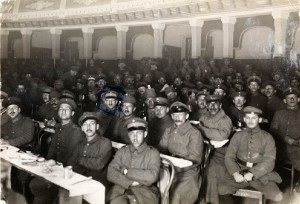The Festival of Liberation at the Front
Yesterday evening, Monday, 14 April 2014, was the start of the eight-day Passover festivities. These kick off each year with the first Seder, the name of which derives from the Hebrew word seder, meaning order, because a particular ritual sequence is observed the entire evening.
The ritual Seder program is laid down in the Haggadah, an often beautifully illustrated book. (Incidentally, some especially precious Haggadot are currently on display in our special exhibition “The Creation of the World” and our director of archives recently described in his blog why even a nondescript Haggadah might be of great value to a museum.) Traditional texts and songs are recited from the Haggadah. Symbolic dishes and drinks deck the tables, ready to be consumed at specific moments during the evening.

German soldiers celebrate Passover in the occupied town of Jelgava (near Riga). © Jewish Museum Berlin, photo: anonymous. Donated by Lore Emanuel
But why is this night different from all other nights? This is a question that Jews all over the world ask themselves year after year at the Seder dinner. The answer is: it is the festival of liberation, for it commemorates the Israelites’ exodus from slavery in ancient Egypt. Everyone is supposed to feel, each year, as if she or he personally is about to leave Egypt. As a token of tribute to this new-won freedom, people comfortably recline while eating and drinking—for to take this position was the prerogative solely of free individuals in antiquity, not of slaves.
In our permanent exhibition this year we are showing a photo taken at a Seder in 1917. However the group of people it depicts appears to be anything but comfortably at ease. The people in this photograph are not celebrating in their trusted family circle or among friends. The photograph shows German soldiers who fought on the Eastern Front during the First World War.
The field rabbi Jacob Sonderling organized a Seder table for them in the palace theatre in Jelgava (German name: Mitau; now in Latvia). That night, in addition to traditional texts, the men sang the German translation of the Dutch hymn of Thanksgiving “Wilt heden nu treden” (We Gather Together). This song in which God’s assistance in combat is requested was a favorite of the then German emperor, Wilhelm.
The small town of Jelgava, part of the Russian Empire at the time, had been under occupation by German troops and in use as a military base since 1 July 1915. Most of the indigenous population had had to leave the city after the German military requisitioned their homes. Today, we can hardly begin to imagine which feelings and thoughts were in the minds and hearts of the German-Jewish soldiers who celebrated the feast of liberation in that place.
Monika Flores Martínez and Julia Kouzmenko, Permanent Exhibition
PS: Our heartfelt thanks to Aldis Barševskis from the Ģ. Eliass Jelgava History and Art Museum for his support of our research.
Hello,
We recently visited the Jewish Museum in Berlin and were interested in one of the featured personalities of the exhibit. The person’s name is Glika. Unfortunately, we did not write down the family name (last name) and thought we might find it on the website for the Museum under the permanent exhibition information. If possible, we would like help in identifying this person.
Thank You.